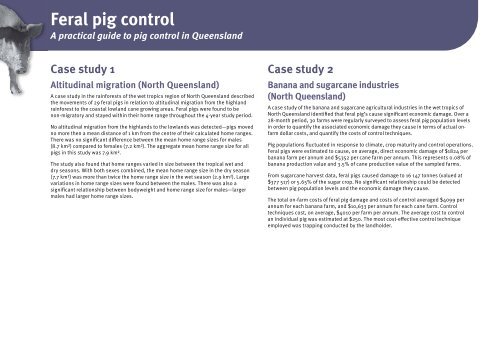Ipa Feral Pig Control Manual - Department of Primary Industries ...
Ipa Feral Pig Control Manual - Department of Primary Industries ...
Ipa Feral Pig Control Manual - Department of Primary Industries ...
Create successful ePaper yourself
Turn your PDF publications into a flip-book with our unique Google optimized e-Paper software.
<strong>Feral</strong> pig control<br />
A practical guide to pig control in Queensland<br />
Case study 1<br />
Altitudinal migration (North Queensland)<br />
A case study in the rainforests <strong>of</strong> the wet tropics region <strong>of</strong> North Queensland described<br />
the movements <strong>of</strong> 29 feral pigs in relation to altitudinal migration from the highland<br />
rainforest to the coastal lowland cane growing areas. <strong>Feral</strong> pigs were found to be<br />
non-migratory and stayed within their home range throughout the 4-year study period.<br />
No altitudinal migration from the highlands to the lowlands was detected—pigs moved<br />
no more then a mean distance <strong>of</strong> 1 km from the centre <strong>of</strong> their calculated home ranges.<br />
There was no significant difference between the mean home range sizes for males<br />
(8.7 km²) compared to females (7.2 km²). The aggregate mean home range size for all<br />
pigs in this study was 7.9 km².<br />
The study also found that home ranges varied in size between the tropical wet and<br />
dry seasons. With both sexes combined, the mean home range size in the dry season<br />
(7.7 km²) was more than twice the home range size in the wet season (2.9 km²). Large<br />
variations in home range sizes were found between the males. There was also a<br />
significant relationship between bodyweight and home range size for males—larger<br />
males had larger home range sizes.<br />
Case study 2<br />
Banana and sugarcane industries<br />
(North Queensland)<br />
A case study <strong>of</strong> the banana and sugarcane agricultural industries in the wet tropics <strong>of</strong><br />
North Queensland identified that feral pig’s cause significant economic damage. Over a<br />
28-month period, 30 farms were regularly surveyed to assess feral pig population levels<br />
in order to quantify the associated economic damage they cause in terms <strong>of</strong> actual onfarm<br />
dollar costs, and quantify the costs <strong>of</strong> control techniques.<br />
<strong>Pig</strong> populations fluctuated in response to climate, crop maturity and control operations.<br />
<strong>Feral</strong> pigs were estimated to cause, on average, direct economic damage <strong>of</strong> $1824 per<br />
banana farm per annum and $5352 per cane farm per annum. This represents 0.08% <strong>of</strong><br />
banana production value and 3.5% <strong>of</strong> cane production value <strong>of</strong> the sampled farms.<br />
From sugarcane harvest data, feral pigs caused damage to 16 147 tonnes (valued at<br />
$377 517) or 5.65% <strong>of</strong> the sugar crop. No significant relationship could be detected<br />
between pig population levels and the economic damage they cause.<br />
The total on-farm costs <strong>of</strong> feral pig damage and costs <strong>of</strong> control averaged $4099 per<br />
annum for each banana farm, and $10,633 per annum for each cane farm. <strong>Control</strong><br />
techniques cost, on average, $4010 per farm per annum. The average cost to control<br />
an individual pig was estimated at $250. The most cost-effective control technique<br />
employed was trapping conducted by the landholder.
















